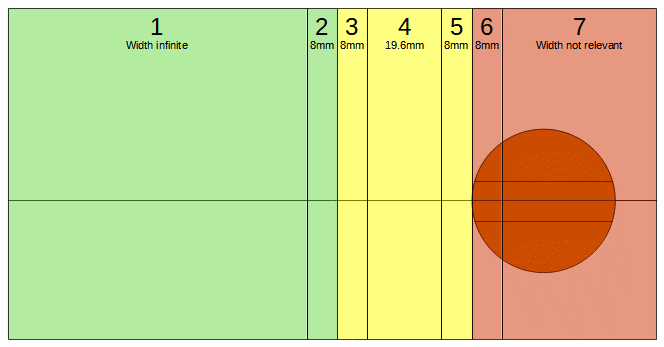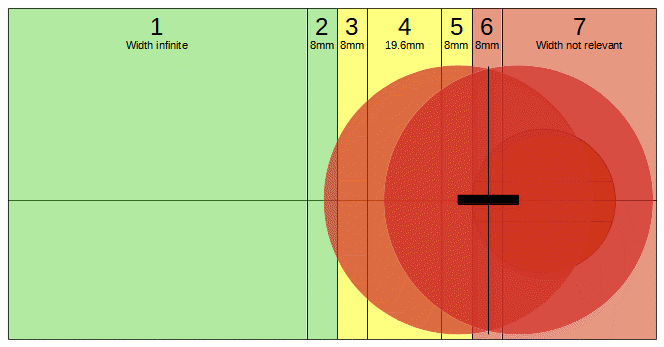(I am indebted to the work of Kartikeya Date. This article includes links to Cricinfo’s coverage of DRS through the years.)
In explanations of the Umpire’s Call category in LBW decisions, it is often said that it gives the benefit of the doubt to the umpire. According to this interpretation, when Hawk-Eye predicts that the simulated trajectory of the ball is within the Umpire’s Call margin (that is, the ball is predicted to hit the stumps but the centre of the ball is predicted to miss), it is not 100% sure that the ball is on track to hit and allows the decision of the on-field umpire to stand for this reason. In fact, the situation is a lot more complicated than this. Umpire’s Call is less about accounting for doubt and more about defining an expert standard for umpires, and a detailed analysis shows that the Decision Review System (DRS) sometimes gives the benefit of the doubt to the batter, sometimes to the umpire, sometimes even to the bowler, and sometimes removes doubt altogether.
What are we talking about when we talk about doubt?
In order to show this I will need to briefly discuss the nature of doubt. This will be unavoidably philosophical but not imponderable. Firstly, there are at least two kinds of doubt. In the first kind, an umpire might have some doubt about whether the ball was going to hit the stumps or miss it by a millimetre. This is common-or-garden, vanilla flavour doubt related to the limitations of the senses. In the second kind, the umpire might have some doubt about whether the ball was going to hit the stumps because of something she could not possibly have predicted, like an exceptionally strong gust of wind or an invisible cousin of Maxwell’s demon loitering about and interfering with the laws of physics. This is not the kind of doubt that we are discussing when we discuss the benefit of the doubt in cricket and it will play no part in the analysis.
Secondly, doubt always belongs to someone or something. It is a property of perceptions, not things. It does not make sense to talk about doubt “out there” in the world, outside of the doubt of a person or machine perceiving the world. So whenever we talk about doubt or the benefit of the doubt, it must be made clear whose doubt we are referring to. A spectator’s? The umpire’s? A player’s? Hawk-Eye’s? This implies that if none of the parties to a particular judgement (an LBW decision, for example) has any doubt about it then there is, as a matter of fact, no doubt about it. The doubt is gone.
Lastly, human perceptions are normally associated with doubt while mechanical measurements are associated with uncertainty. Whether or not there is a fundamental difference between doubt and uncertainty is not significant for the analysis and they will be treated as equivalent.
Analysis: introduction
With these points about doubt in mind let’s consider what happens when a bowler appeals for LBW. The umpire may have some doubt about whether or not the ball would have gone on to hit the wickets and therefore whether to give the batter Out or Not out. He must choose one or the other so he has to set aside whatever doubt he may have. Generally he will give the benefit of the doubt to the batter, which is to say that the he will set aside the possibility that the ball would have gone on to hit the stumps. The players may now have some doubt about whether the umpire made the correct decision. They must choose whether or not to call for a review, so they have to set aside their doubt. If they decide not to call for the review, they will give the benefit of their doubt to the umpire, which is to say that they will set aside the possibility that the umpire’s decision was incorrect. If they decide to call for the review, the DRS makes a prediction about the ball’s trajectory and reports back to the on-field umpire whether it was ‘Hitting,’ ‘Missing’ or ‘Umpire’s Call.’ It can only report one of these three categories but it too may have some doubt which it has to set aside in order to give an unambiguous report: in an experimental study by MIT commissioned by the ICC, the maximum horizontal error of the trajectory prediction was found to be 8mm in either direction (it is slightly more than 8mm in the vertical direction). I take this to mean that the DRS has no doubt that the “real”1 trajectory is within a 16mm wide horizontal interval, but has some doubt about where exactly it is within this interval. The width of the Umpire’s Call margin, meanwhile, is much wider: 35.6mm to be precise (the radius of the ball). As a result, assuming that the ball trajectory that the DRS reports to the on-field umpires is at the centre of the 16mm interval, it falls into one of seven ‘doubt zones,’ which are illustrated in the following diagram and then comprehensively discussed.

Analysis: zones 1, 4 and 7
If the DRS reports that the ball is in zone 1, it is certain that the ball is on track to miss, so it will report “Missing.’ It has no doubt. If any player or umpire has some doubt about the trajectory, the effect of the DRS report is to remove it. Similarly if the DRS reports that the ball is in zone 7, it is certain that the ball on track to hit and that the centre of the ball is on track to hit, so it will report ‘Hitting’ and remove any doubts about the trajectory.

If the report is in zone 4, DRS is certain that the ball is on track to hit and certain that the centre of the ball is on track to miss. The report is therefore ‘Umpire’s Call’ and any doubt among the players and on-field umpires about the trajectory is removed: everyone is now certain that the ball is on track to hit. If the on-field umpire’s decision was Not out, she may uphold her decision but not because she has received the benefit of the doubt. The doubt is gone! The reason she may uphold her decision is because her original decision met a certain expert standard. This standard is set by the ICC and is influenced by spectator considerations: the radius of the ball is a visually convenient but arbitrary quantity. It may upset some people to know that umpires are being recognised as fallible experts whose errors are allowed to stand but I for one have no problem with it.

In these three cases (zones 1, 4 and 7), the effect of the DRS report is to remove doubt. It may not be certain about the “real” trajectory of the ball but it is certain about whether or not the ball and the centre of the ball are on track to hit. In the remaining four cases (zones 2, 3, 5 and 6), the DRS has some doubt that it has to deal with.
Analysis: zone 2
If the report is in zone 2, it falls into the category ‘Missing.’ The DRS is certain that the centre of the ball is on track to miss but there is actually a low probability, less than 50%, that the ball is on track to hit. The DRS sets aside this possibility when it reports ‘Missing,’ rather than ‘Umpire’s Call.’ This is the most rational thing to do, given that it must make an unambiguous report in terms of the three categories. In the case where the on-field umpire’s original decision was Out, the effect of setting aside the low probability that the ball is on track to hit and reporting ‘Missing’ is to withhold grounds for the on-field umpire to uphold the original ‘Out’ decision. In other words, the benefit of the DRS’s doubt goes to the batter.

Analysis: zone 3
Moving on to zone 3, the DRS is still certain that the centre of the ball is on track to miss, but now there is a high (greater than 50%) probability that the ball is on track to hit. It therefore sets aside the possibility that the ball is on track to miss and reports ‘Umpire’s Call,’ not ‘Missing.’ This is again the most rational thing to do, given that it must make an unambiguous report in terms of the three categories. By giving her grounds to uphold her original decision, the DRS gives the benefit of its doubt to the umpire.

Analysis: zone 5
Zone 5 is similar to zone 3. Now, the DRS is certain that the ball is on track to hit. There is a high probability that the centre of the ball is on track to miss but a small possibility that the centre of the ball is on track to hit. The DRS sets aside this small possibility and reports ‘Umpire’s Call’ rather than ‘Hitting,’ giving the benefit of the doubt to the umpire. Again, it’s the most sensible thing to do.

Analysis: zone 6
Finally, in zone 6 the DRS is once again certain that the ball is on track to hit but now the probability that the centre of the ball is also on track to hit is greater than the probability that it is on track to miss. The DRS sets aside the smaller probability and reports ‘Hitting,’ not ‘Umpire’s Call.’ This is the most rational thing to do, given that it must make an unambiguous report, but it has an interesting consequence. In the case where the on-field umpire’s original decision was Not out, the effect of setting aside the low probability that the centre of the ball is on track to miss and reporting ‘Hitting’ is to withhold grounds for the on-field umpire to uphold their original ‘Not out’ decision. In other words, in zone 6 the benefit of the DRS’s doubt goes to the bowler.

Conclusion
It has been shown that the DRS sometimes gives the benefit of the doubt to the bowler. This is probably not intentional. It has also been shown that on-field umpire’s decisions may sometimes be upheld even when there is no doubt that the ball is on track to hit the stumps. Does this mean that the protocols need to be redesigned to get rid of these outcomes? I don’t think so.
To begin with zone 6, where the benefit of the doubt goes to the bowler, is very narrow. Moreover, as the technology improves, it will only get narrower (along with zones 2, 3 and 5). Meanwhile, the current DRS protocols, in my view, do an excellent job of balancing the interests of players, umpires and spectators. Rather than redesigning the protocols, cricket should use higher-speed cameras and other technologies that will reduce uncertainty. This will not lead to the redundancy of ‘Umpire’s Call’ however because this category is not about accounting for the uncertainty of the DRS trajectory prediction but about defining an expert standard for umpires. This standard is not set in stone but any changes must balance the interests of all parties, umpires not excluded.
1The word ‘real’ is in scare quotes because the trajectory is a prediction of what would have happened in a counterfactual scenario, not a judgement about something that actually happened.